Chapter 5 Combat
In this chapter we provide the rules for resolving a combat encounter.
5.1 Combat Fundamentals
In Square Fireballs, a combat encounter represents a short, violent conflict between an adventuring party of Player Characters and a group of Monsters controlled by the Game Master.
In combat, each character (whether a Player Character or a Monster) takes turns to carry out actions such as moving, attacking enemies, or healing or assisting allies. Some actions succeed automatically, whereas others require the character to make a successful die roll. For example, movement through normal terrain is resolved automatically, with the player stating the character’s movement path and changing the character’s position accordingly. On the other hand, attacking requires the character to roll against the enemy’s defense to determine if the attack hits, and then rolling again to determine the damage dealt by the attack.
The goal of a combat encounter is incapacitate all enemy characters, typically by inflicting enough damage to reduce them below 0 Hit Points. A combat can also end when either the monsters or the Player Characters decide to flee.
5.2 The Combat Map
5.2.1 Distances
The following figure illustrates how distances work. The number in each square represent the distance between the Wizard and that square.
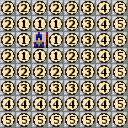
Map distances
This figure shows some specific examples of squares that are 1,2,3,4, and 5 units away from the Wizard
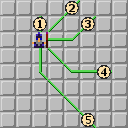
Map distance examples
5.2.2 Lines
Due to the way that distances are defined in our maps, certain geometrical elements like lines are not as straightforward as one would expect. In the game map, a Line is:
- one of the shortest paths between two points (note that there can be several paths that meet this requirement!)
- composed of up to two straight segments: one in the horizontal or vertical direction, and another in a diagonal direction.
For any two points in the map, there will be one or two Lines that meet this definition.
This figure shows the simplest types of lines, composed of a single horizontal (1), vertical (2) or diagonal (3, 4) segment. Note that when two points can be joined by a single-segment Line, there will only be a single Line between these points.
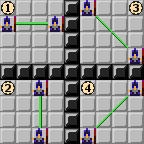
Line definition
This figure shows examples of two-segment lines. When two points can be joined by a two-segment line, there will always be two such lines between these points.
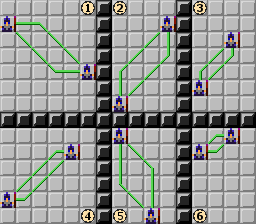
Line examples
5.2.3 Close and Area powers: Burst, Blast, Line
Area Burst
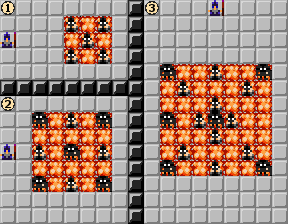
Area Burst
Range of Area Burst powers
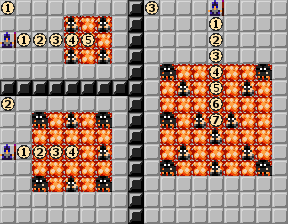
Area Burst range
Close Burst
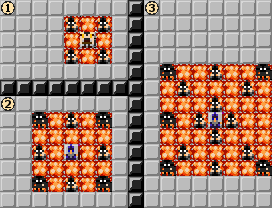
Close Burst
TODO: Blast TODO: Line
5.2.4 Line of Sight and Cover
Basic cover
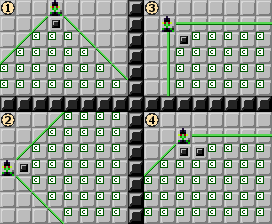
Cover basics
Basic cover examples with attacking characters
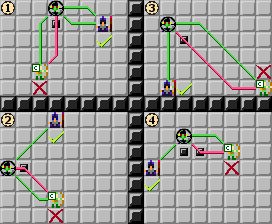
Cover basic examples
Cover for large creatures
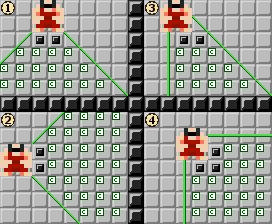
Cover for large creatures
Examples of cover for large creatures with attacking characters
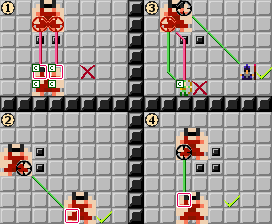
Cover for large creatures - examples
Basic Line of Sight
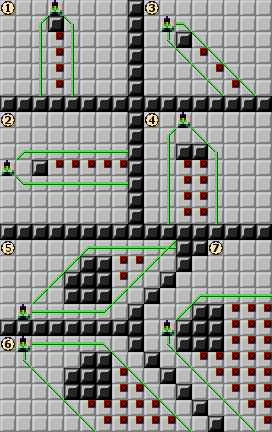
Line of Sight
Examples of Line of Sight with enemy characters
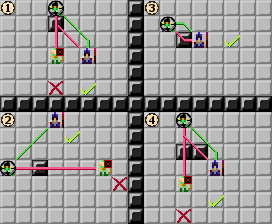
Line of Sight - examples
Examples of Line of Sight with walls and doors
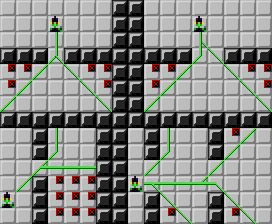
Line of Sight - advanced
Combining Line of Sight, Cover, Superior Cover
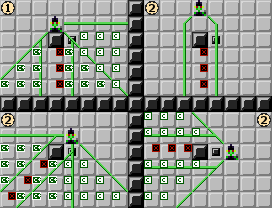
Line of Sight and Cover
5.2.5 Light and Concealment
Light
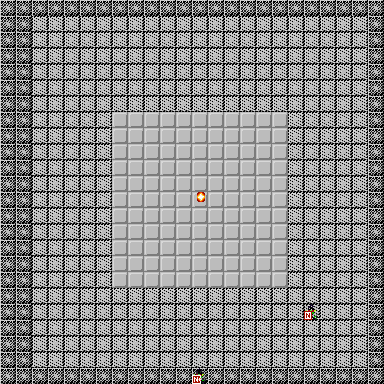
Light basics
more light
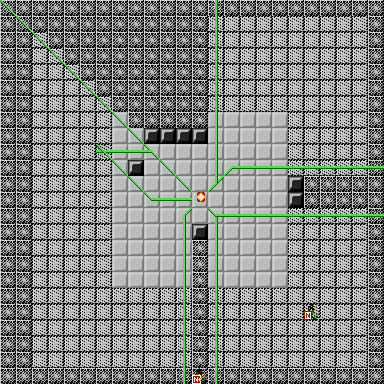
More Light
Yet more light
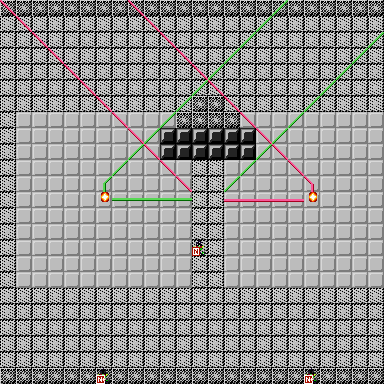
Yet More Light
5.2.6 Flanking
Flanking basics
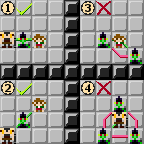
Flanking basics
Flanking for large creatures
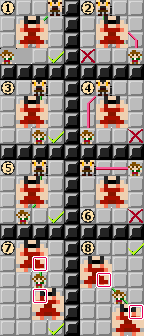
Flanking for large creatures
5.3 Combat Sequence
The combat sequence can be summarized as follows:
- Before the start of combat, determine the location of all characters in the combat map.
- The GM arranges all monsters in the encounter into monster groups.
- All characters start combat in Total Defense.
- At the start of combat, all characters roll initiative to determine the order in which they act.
- Each round, all characters take turns in order of initiative.
- Combat ends when either all PCs or all monsters are knocked out or have run away.
Definitions:
- Initiative Value: Value used to determine acting order in combat. Characters with higher initiative act first.
- Group of monsters: Several monsters that share the same Initiative Value
- Combat turn: Turn of action for a single PC or group of monsters. A character can usually take a Minor Action, a Move Action, and a Standard Action per turn.
- Combat round: Sequence of turns for all characters in an encounter. Once all characters have acted, a new round begins.
5.3.1 Grouping monsters
Unlike PCs, who roll for initiative individually, monsters are often grouped together to speed up the flow of combat. GMs have freedom to arrange monster groups as they see fit, but they should apply the following guidelines:
- Each monster group should be composed of identical monsters, or monsters with the same Initiative modifier.
- Each combat should have between 2 and 4 monster groups, if possible.
5.3.2 Defending at the start of combat
At the start of combat, and before any character takes an action, all characters use Total Defense as a Free Reaction, unless they are Surprised (see Ambushes below):
Total Defense - Maneuver
Utility
Standard Action -
Effect: Gain +4 to all defenses until your next turn.
5.3.2.1 Ambushes
By default, at the start of a combat encounter all combatants are ready and aware of their opponents. However, it is possible for a group of characters to sneak on their enemies and catch them totally or partially by surprise - we call this an Ambush. There are two types of Ambush, depending on their degree of success:
- Total Ambush: All enemies start combat Surprised.
- Partial Ambush: Some enemies start combat Surprised.
| Status | Downgrade | Effects |
|---|---|---|
| Surprised | No Downgrade | - Cannot use Full Defense at the start of combat. - Condition ends when attacked. - When this character would take the turn, they use Full Defense, end the turn, and are no longer considered Surprised. |
A character that is not surprised can warn Surprised allies with the Raise the Alarm maneuver:
Raise the Alarm - Maneuver
Utility
Minor Action - Close Burst 5 - allies in burst -
Effect: Each Surprised target can Roll a Save against the Surprised condition.
Use the rules in the Skills chapter to determine whether the PCs can successfully ambush their enemies… or are ambushed by them.
5.3.3 Rolling Initiative
At the start of combat, each PC or group of monsters Rolls Initiative as follows:
Initiative Value = 1d20 + Initiative ModifierAfter rolling initiative, put all PCs and groups of monsters in a list, ordered by Initiative Value (higher values first). This list will be used as reference to determine the order of actions for this combat encounter. In case of a tie, sort the characters tied in initiative as follows:
- Try to alternate PCs and monsters: If PCs and monsters are tied for the same initiative value, and the character acting right before that initiative value is PC, the monsters win the tie. If the character acting right before that initiative value is a monster, the PCs win the tie.
- Choose randomly. If there are multiple characters tied for the same initiative value, have them roll a die and sort them from highest roll to lowest.
5.3.4 Combat Escalation
See Escalation Die in the Introduction chapter. To summarize: each combat round starting with the third, add 1 to the Escalation Die. All characters gain a bonus to Hit Rolls equal to the Escalation Die.
5.3.5 Rolling Initiative mid-combat
If new combatants enter an encounter, the GM can use one of the following options:
- Start Over: Add the new characters to the combat map. All characters use Total Defense as a Free Reaction (unless they are Surprised), then Roll Initiative again. Set the Escalation Die to 0.
- Keep Initiative: Add the new characters to the combat map. The new characters use Total Defense as a Free Reaction (unless they are Surprised), then Roll Initiative. Update the list of initiative values and resolve initiative value ties as usual. Reduce the Escalation die by 1, to a minimum of 0.
Regardless of the method used, any active powers, cooldowns or status effects remain unaffected.
The GM can choose a solution for rolling initiative mid-combat as they see fit. We recommend using the Start Over option only when many new characters enter combat - the equivalent of 2 Standard monsters or more.
5.4 Resource Management
5.4.1 At-Will, Encounter and Daily powers
5.4.2 Action Points
5.4.3 Damage, Incapacitation and Healing
5.5 Actions
Types of action:
- Move : Action taken during a character’s turn, usually to change position. A character can take 1 Move Action/turn
- Standard : Action taken during a character’s turn, usually to make an attack. A character can take 1 Standard Action/turn
- Minor : Action taken during a character’s turn, usually for something quick like picking up an object. A character can take 1 Minor Action/turn.
- Free : Action taken during a character’s turn. Can be in response to a trigger.
- Reaction : Action taken outside a character’s turn, in response to a trigger. A character can take 1 Reaction/Round.
- Free Reaction : Action taken outside a character’s turn, in response to a trigger. Counts as both a Free Action and a Reaction. Does not count toward the limit of 1 Reaction/Round.
Reaction Keywords: The following keywords can apply to Reactions, Free Reactions, and to Free Actions with a trigger, to grant them special properties:
- Interrupt : Reaction resolves before the triggering event completes.
- Automatic : Can always be taken, even if the character is Unconscious, incapacitated or otherwise unable to take actions at that time.
Resolving Interrupts:
- An Interrupt action triggering in the middle of another character’s action can stop the triggering action. For example, a character Immobilized by an Interrupt while moving stops their movement immediately.
- An Interrupt action can include Forced Movement. A character whose position changed because of an interrupt may find that some targets for the triggering action are now at a different range, or outside of range altogether. In that case, apply any new range modifiers as appropriate, and remove any out of range characters as valid targets. No new targets can be picked - if the triggering action no longer has enough valid targets, it stops.
- If the interrupted action included movement, and the Interrupt caused Forced Movement, the interrupted character subtracts the distance of the Forced Movement from the remaining movement distance. Then, if they have any movement distance left, they use it to move to a new position. This new position does not need to match the movement as declared before the interrupt.
Opportunity Attacks : The most common type of Reaction is the Opportunity Attack, a combat maneuver that all characters can make to attack adjacent enemies moving or making ranged attacks:
Opportunity Attack - Maneuver
Attack
Free Reaction (Interrupt) - (Trigger: An adjacent enemy moves or makes a Ranged or Area attack) -
Effect: You make a Melee Basic Attack against the triggering enemy, adding your Opportunity Modifier to the Hit Roll
Limits to actions:
- During a character’s turn:
- One each of : Minor Action, Move Action, Standard Action.
- One Free Action Attack.
- Any number of non-attack Free Actions, but each power can only be used once per turn this way.
- Outside a character’s turn:
- One non-Free Reaction per round.
- One Free Reaction attack per turn.
- Any number of non-attack Free Reactions per turn, but each power can only be used once per turn this way.
- An Automatic action can always be taken, at any time, regardless of other action limits.
Compatibility Note: Legacy rules have granted actions as Free Actions. They are now Free Reactions.
Example: “an ally can make a basic attack as a Free Action” becomes "an ally can make a basic attack as a Free Reaction.5.6 Movement
5.7 Attacking
5.7.1 Range and Targeting
5.7.2 Hit Roll
5.7.2.1 Hit Modifiers
| Condition | Modifier |
|---|---|
| Defender grants Advantage to Attacker | +2 |
| Defender has any Cover from Attacker | -2 |
| Defender has Superior Cover from Attacker | -3 |
| Defender has any Concealment from Attacker, attack is Melee or Ranged | -2 |
| Defender has Superior Concealment from Attacker, attack is Melee or Ranged | -3 |
| Attacker is Hindered | -2 |
| Ranged attack at Long Range | -2 |
Note: Characters with Superior Cover also benefit from regular Cover, so attacks against them will have a total modifier of -5. Likewise, Characters with Superior Concealment also benefit from regular Concealment, and attacks against them have a total modifier of -5.
5.7.2.2 Critical Hits
5.7.3 Damage Roll
5.7.3.1 Miss Damage
5.8 Status Effects
Some powers or abilities can apply status effects on characters. A character afflicted by a status effect suffers penalties that depend on the type condition - see the table below for details.
Normally, the effect creating a status effect states its duration, which is often a combat turn, but can also last until the character saves against the effect, or even indefinitely, depending on the case. Certain status effects have special rules affecting their duration, typically in the form of conditions that end the effect prematurely.
It is possible for a character to be affected by multiple instances of a status effect. The penalties from instances of the same condition don’t stack unless otherwise stated.
Some status effects care about the source of the effect. For example, in the case of the Taunt status effect, the Taunted character does not suffer penalties when attacking the Taunting character. If multiple instances of such an effect are affecting a character, it is important to keep track of the source of each one.
5.8.1 Downgrading status effects
Some abilities allow a character to downgrade a status effect. To downgrade a status effect, check the Downgrade column in the status effect table: the character treats the status effect as if it was the downgraded one for the duration of the downgrade. Note that a downgrade may have a shorter duration than the status effect it applies to - in that case, the original effect applies again when the Downgrade ends.
If the downgrade for a status effect is listed as No Effect, the effect is completely ignored while Downgraded. Likewise, if it is listed as No Downgrade, the effect cannot be downgraded.
A status effect can only be downgraded once at any given time. Notably, this means that abilities that downgrade multiple types of status effect do not stack with themselves. As an example, consider a character with the ability to downgrade the Slowed and Immobilized status effects. If that character becomes Immobilized, the downgrade would allow them to act as if they were Slowed instead - but it wouldn’t let them ignore the Slow.
5.8.2 Standard Status Effects
| Status | Downgrade | Effects |
|---|---|---|
| Blinded | Dazzled | - Grants Advantage (+2 to be hit) - Cannot Flank - Treats other characters or objects as having Superior Concealment (-5 to hit them). - No line of sight to other characters or objects - +1 DC to Perception Skill Checks. |
| Charmed | No Effect | - Cannot attack enemies Charming the character. - A character may be Charmed by multiple enemies at a time. - Automatically ends if attacked by an enemy Charming the character. |
| Dazed | Shocked | - Grants Advantage (+2 to be hit) - Cannot Flank - Cannot use Opportunity or Immediate Actions - Each turn, can use a Minor Action and either a Standard Action or a Move Action. |
| Dazzled | No Effect | - Treats all enemies as having Concealment (-2 to hit them) or, if already in Concealment, as having Superior Concealment (an additional -3 to hit them). |
| Dominated | Charmed | - Cannot take actions - Cannot Flank - When damaged, can roll a Save to end this condition. - The dominating character can spend a move action to make the dominated character move its speed. (This counts as forced movement) - The dominating character can spend a standard action to make the dominated character use an at-will attack. (This counts as a forced attack) |
| Flanked | No Downgrade | - Grants Advantage on Melee attacks (+2 to be hit) |
| Grabbed | No Effect | Cannot move -When grabbed, the character is pulled to a square adjacent to the grabbing character. -The condition ends if at any time the grabbed character is not adjacent to the grabbing character. -Grabbed character can use the Escape combat maneuver to end the condition. (Move Action, roll save to end grab from one enemy) -If forced movement would cause the grabbed character and the grabbing character to no longer be adjacent, the grabbed character can roll a Save to end this condition. If the condition doesn’t end this way, the forced movement is negated -A character may be Grabbed by multiple enemies at a time. |
| Helpless | No Downgrade | - Grants Advantage (+2 to be hit) -Melee Attacks against the character gain +10 Crit Range |
| Hindered | No Effect | -2 Hit |
| Immobilized | Slowed | Cannot move |
| Taunted | No Downgrade | - -2 Hit on attacks that ignore the Taunt (see sidebar) - A character may be Taunted by multiple enemies at a time. |
| Petrified | Stunned | - Grants Advantage - Cannot take actions - Cannot Flank - Gains Resist (all). |
| Prone | No Downgrade | Condition lasts indefinitely until the character stands up (e.g. by spending a move action on the Stand Up maneuver) -Cannot make any movement other than crawling (e.g. by having a Crawl Speed, or by using the Crawl combat maneuver: Move Action, crawl 1) -Hindered (-2 Hit) -Grants Advantage against melee attacks (+2 to be hit) -Against non-melee attacks, gains Cover (-2 cover penalty to attack rolls) or, if already in Cover, gains Total Cover (an additional -3 cover penalty to attack rolls) |
| Restrained | Grabbed | - Cannot move - Ignores forced movement - Grants Advantage (+2 to be hit) - Hindered (-2 Hit) |
| Shocked | No Effect | - Cannot Flank - Cannot use Opportunity or Immediate Actions |
| Slowed | No Effect | - For each square moved, must spend an additional square of movement |
| Stunned | Dazed | -Cannot attack -Cannot move -Can only take one action per turn - Cannot Flank -Cannot use Reactions -Grants Advantage (+2 to be hit) |
| Unconscious | No Downgrade | - When a character falls unconscious, they are knocked prone. -When damaged, if the character has 1 or more remaining hit points after receiving the damage, the condition ends. - Helpless (+2 to be hit, enemy melee attacks gain +10 Crit Range) - Cannot take actions - Cannot see. |
| Weakened | Partially Weakened | - Damage dealt is halved - Healing granted or received is halved - Shield Points granted or received are halved |
| Partially Weakened | No Effect | - Damage dealt is reduced by 1/4 - Healing granted or received is reduced by 1/4 - Shield Points granted or received are reduced by 1/4 |
| Surprised | No Downgrade | - Cannot use Full Defense at the start of combat. - Condition ends when attacked. - When this character would take a turn, they use Full Defense, end the turn, and are no longer considered Surprised. |
Tip - Hindered: Many types of action can cause a character to be Hindered for a turn. These include combat maneuvers like Shift, Charge, Stand Up, Quick Draw,
Sidebar: ignoring Taunts
An attack by a Taunted character ignores a Taunt if it targets an enemy not taunting the character. The following exceptions apply:
- If the attack targets multiple characters, and all enemies taunting the character are already targeted, any additional targets do not ignore the Taunt.
- If multiple attacks are made in sequence as part of the same attack power (e.g. primary and secondary attacks), once all enemies Taunting the character have been targeted at least once, any additional targets do not ignore the Taunt.
- If an attack originally does not ignore the Taunt, and the attack targets are somehow changed by an enemy action or other effect, this does not cause the attack to ignore the Taunt.
- If an attack originally does not ignore the Taunt, and the attacker becomes Taunted during the attack (e.g. by an enemy reaction), this does not cause the attack to ignore the mark.
Compatibility Note: Defender Aura
Some characters in compatible books have the Defender Aura power. The effect of this power should be replaced with the following:
“Enemies in the aura are Taunted by you.”
Compatibility Note: ignoring Taunts
Any reference from compatible books to effects that trigger when a Taunted character ‘makes an attack that does not include the Taunting character as a target’ should use the rules for ignoring Taunts described above.
5.8.3 Stealth status effects
These effects are used by characters trying to hide in combat. Unlike other status effects, these are mostly beneficial and often entered voluntarily.
| Status | Effects | Ends |
|---|---|---|
| Shrouded | Cannot be targeted by Ranged attacks, or Reaction attacks -Cannot be Charged -Cannot make Reaction attacks |
Condition is lost: -After attacking -After moving - If, at the end of a character’s action, the Shrouded character doesn’t have Cover (other than Body Cover) or Concealment against all enemies. |
| Hidden | Cannot make Reaction attacks -Gains Advantage when attacking -Cannot be targeted by Melee or Ranged powers -Cannot be targeted by a Close or Area power unless it targets a non-Hidden character. -Location unknown to other characters |
Condition is lost: - After attacking - After moving - If, at the end of a character’s action, the Hidden character doesn’t have Cover (other than Body Cover) or Concealment against all enemies. |
Tip: Although a Hidden character´s current location is unknown, other characters can guess it based on context: where the Hidden character was last seen, what suitable hiding locations are in the area, etc.
Clarification: Actions that grant the Shrouded or Hidden condition do not cause the loss of that condition if they include attacks or movement.
5.8.4 Special Status Effects
These effectsare rarely used, typically by monsters.
| Status | Downgrade | Effects |
|---|---|---|
| Swallowed | Grabbed | -When swallowed, a character disappears from its current position. When the condition ends, the character reappears in a square of his choice as close as possible to the swallower. - Can spend a move action to make an Escape Check (see sidebar). If successful, condition ends. - Does not occupy a space. - Can only take one action per turn. - Only has line of effect and line of sight to and from the swallower, and other characters and objects swallowed by it. - The inside of the swallower, and swallowed characters and objects, are in total darkness unless otherwise specified. Swallowed characters can use any light source to illuminate the inside of the swallower and all characters and objects swallowed by it. - When using a burst or blast power while swallowed, the swallower and all characters and objects swallowed by it are included in the burst or blast. |
| Exiled | Grabbed | - When exiled, a character disappears from its current position. - When the condition ends, the character reappears on this position or, if not possible, in the closest ground square of his choice, unless the exiling effect states otherwise. - Does not occupy a space. - No line of sight to and from other creatures or objects unless the exiling effect states otherwise. - No line of effect to and from other creatures or objects unless the exiling effect states otherwise. |
5.8.5 Legacy status effects
In legacy rules, status effects are referred to as conditions.
Some status effects have been renamed from legacy rules:
- Deafened: Renamed to Dazzled
5.8.6 Forced Attacks
Certain powers or effects allow one character to force an enemy to make an attack. Such attacks are considered forced attacks, and use the following rules:
- If there are different attack powers that meet the requirement for the forced attack (e.g. basic attacks or at-will attacks), the character forcing the attack is aware of all available options and can choose any of them.
- For the chosen attack power, the character forcing the attack can make any relevant decision, including (but not limited to) targets, area of effect, forced movement caused by the attack.
- A character forced to make an attack cannot target himself with the forced attack.
- Forced attacks ignore the Taunted status effect . A character making a forced attack counts as not Taunted, for the purposes of that attack.
- Forced attacks never trigger opportunity attacks.
5.9 Forced Movement
Certain powers or effects allow one character to force an enemy to make a move. Such movements are considered forced movement, and use the following rules: - Forced Movement can be caused by Push, Pull and Slide effects. In these cases, the amount of squares of forced movement is indicated in the effect causing the forced movement. - If a Push, Pull or Slide effect ends before the full distance is moved because the moved character collides with an obstacle or another character, each character involved in the collision takes Forced Movement Damage. This damage scales with the tier of the source of the forced movement as follows: 1d4 for Heroic sources, 2d4 for Paragon effects for Paragon sources, and 4d4 for Epic sources. - Forced Movement can also be caused by effects that force the character to take an action to move in a particular direction. In this case, the amount of squares of forced movement depends on the character’s speed unless otherwise stated, and is affected by any status effects or other conditions that restrict movement. - Forced movement never triggers opportunity attacks or other character powers that would trigger on movement. Traps and hazardous terrain trigger normally.
5.9.1 Push
Push a single unit
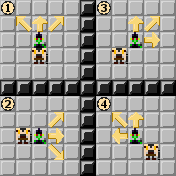
Push 1
Push a single unit, showing Lines
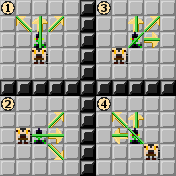
Push 1
Push multiple units
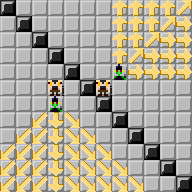
Push multiple squares
Push multiple units, showing Lines for path
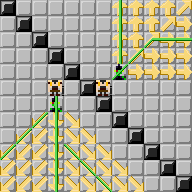
Push multiple squares
Push single unit at range, showing Lines
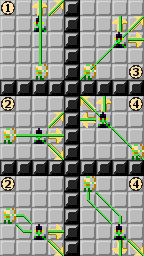
Push at range
Push multiple units at range, showing Lines
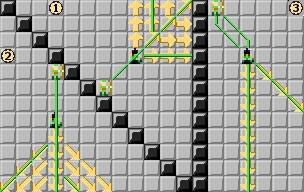
Push at range
5.9.1.1 Pull
Pull at range
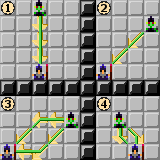
Pull
5.9.1.2 Slide
Slide a single unit, at range (1) and in melee (2)

Slide
Slide multiple units, at range (1) and in melee (2)
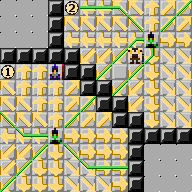
Slide
5.9.2 Saving against Forced Movement
Characters can use Forced Movement to get their opponents into a damaging area, or to crash them into a wall. This is considered fair game, and no saves are normally allowed. However, there is an exception to this: whenever forced movement would move a character off a cliff (or equivalent) and cause them to fall, that character is allowed to make a save to avoid the effect. The character takes a penalty to the save equal to the remaining squares of Forced Movement. On a successful save, the Forced Movement stops before the character is moved off the cliff, and the character is knocked prone.
At the GM’s discretion, PCs (but not monsters) can also benefit from this rule whenever Forced Movement would put them in a particularly deadly position, such as a pool of lava.
Example 1: A goblin is adjacent to a precipice. A PC uses an attack with Push 1 to try to make the goblin fall: the goblin can attempt a save without penalties to avoid this effect and become Prone instead.
Example 2: A goblin is 1 square away from a precipice. A PC uses an attack with Push 4 to try to make the goblin fall: the goblin can attempt a save to avoid this effect and become Prone instead. Since there are 4 squares of forced movement and 2 are spent to move the character over the precipice, the excess distance is 2 squares, and the goblin takes a -2 penalty to the save.
5.10 Combat Maneuvers
5.10.1 PC Maneuvers
Melee Basic Attack (Weapon) - Maneuver
Attack - Weapon
Melee - Primary Ability vs Arm
Hit: 1W+Primary Ability.
Level 21: Increase Hit damage to 2W+Primary Ability.
Ranged Basic Attack (Implement) - Maneuver
Attack - Implement
Implement Range - Primary Ability vs Arm
Hit: 1d6+Primary Ability.
Level 21: Increase Hit damage to 2d6+Primary Ability.
Ranged Basic Attack (Weapon) - Maneuver
Attack - Weapon
Weapon Range - Primary Ability vs Arm
Hit: 1W+Primary Ability.
Level 21: Increase Hit damage to 2W+Primary Ability.
Use Action Point - Maneuver
Utility
Free Action -
Effect: Make an Action Point Check. If successful, you can spend an Action Point to gain an extra Standard Action.
(You can only spend one Action Point per encounter.)
Second Wind - Maneuver
Utility - Encounter
Standard Action -
Effect: Heal a Surge. Gain +4 to all defenses until your next turn.
5.10.2 Core Maneuvers
Opportunity Attack - Maneuver
Attack
Free Reaction (Interrupt) - (Trigger: An adjacent enemy moves or makes a Ranged or Area attack) -
Effect: You make a Melee Basic Attack against the triggering enemy, adding your Opportunity Modifier to the Hit Roll
Shift - Maneuver
Utility
Move Action -
Effect: Shift 1. If you move away from an adjacent enemy this way, you are Hindered this turn.
Total Defense - Maneuver
Utility
Standard Action -
Effect: Gain +4 to all defenses until your next turn.
Walk - Maneuver
Utility
Move Action -
Miss: Move your Speed.
5.10.3 Miscellaneous Maneuvers
Draw - Maneuver
Utility
Move Action -
Effect: Move 1. Sheathe or store any number of items from your hands. Draw, or pick up from the ground, up to one item per hand.
Point Blank Shot - Maneuver
Utility
Minor Action -
Effect: Until end of turn, you are Hindered, and making Ranged or Area attacks targeting adjacent enemies does not provoke opportunity attacks
Quick Draw - Maneuver
Utility
Minor Action -
Effect: Drop any number of items from your hands. Draw up to one item per hand. You are Hindered this turn.
Raise the Alarm - Maneuver
Utility
Minor Action - Close Burst 5 - allies in burst -
Effect: Each Surprised target can Roll a Save against the Surprised condition.
5.10.4 Move Maneuvers
Charge - Maneuver
Attack
Standard Action -
Effect: You are Hindered this turn. Move your Speed and make a Melee Basic Attack. You can’t move this turn
Run - Maneuver
Utility
Standard Action -
Effect: Move your Speed.
Stand Up - Maneuver
Utility
Move Action -
Effect: You stop being Prone, and you are Hindered this turn. Move 1
5.10.5 Stealth Maneuvers
Enshroud - Maneuver
Utility
Standard Action -
Effect: If you are in Cover (other than Body Cover) or Concealment from all enemies, you become Shrouded. If you were already Shrouded, you become Hidden instead.
Hide - Maneuver
Utility
Standard Action -
Effect: If you are in Cover (other than Body Cover) or Concealment from all enemies, make a Medium Stealth check. On a success, you become Hidden.
DC modifiers:
- +1/+2/+3: Nearby enemies Trained/Master/Grandmaster in Perception (use highest).
- +1: You are within 4 squares of an enemy.
- -1: You have Total Cover or Total Concealment from all enemies.
Search - Maneuver
Utility
Standard Action -
Effect: If there are any Hidden or Shrouded enemies nearby, make a Medium Perception check. On a success, they are no longer Hidden or Shrouded.
DC modifiers:
- +1/+2/+3: Hidden enemies Trained/Master/Grandmaster in Stealth (use highest).
- -1: You are within 4 squares of a Hidden enemy.
- +1: Hidden enemies have Total Cover or Total Concealment from you.
Sneak - Maneuver
Utility
Move Action -
Effect: Special: Use only while Shrouded or Hidden. Effect: Move half your Speed. This movement does not cause you to lose Shrouded or Hidden.
Spot - Maneuver
Utility
Minor Action -
Effect: Shrouded enemies within 2 or less squares of you are no longer Shrouded.
Hidden enemies within 2 or less squares of you become Shrouded instead.
5.10.6 Advanced Miscellaneous Maneuvers
Drag - Maneuver
Attack
Move Action -
Effect: You are Hindered this turn. Move, then Pull all enemies Grabbed by you that many squares. This movement does not provoke Opportunity Attacks from enemies Grabbed by you, and it does not end the Grab. The distance moved depends of the size of the largest enemy Grabbed by you:
- Enemy 2 or more sizes smaller than you: Move half your speed.
- Enemy your size, 1 size smaller than you or 1 size larger than you: Move 1.
- Enemy 2 or more sizes larger than you: Can’t move.
Special: Use only if you are Grabbing an enemy.
Grab - Maneuver
Attack
Standard Action - Melee - H vs Ref
Hit: Grabbed.
Push - Maneuver
Attack
Standard Action - Melee - H vs For
Hit: Push 1.
Administer Potion - Maneuver
Utility
Standard Action - Melee - targets an ally -
Effect: The target uses a Potion carried or held by you or the target.
Escape - Maneuver
Utility
Move Action -
Effect: Use only while Grabbed. You are Hindered this turn. Roll a Save to stop being Grabbed by one enemy. If you are larger than the Grabbing enemy, gain a +3 bonus to the save for each size category difference.
First Aid - Maneuver
Utility
Standard Action - Melee - targets a Dying ally -
Effect: The target is no longer Dying.
Pierce - Maneuver
Utility
Minor Action -
Effect: Choose an enemy you can see and name a type of resistance. On your attacks against that enemy this turn, that resistance is downgraded. You are Hindered this turn.
Ready Melee Attack - Maneuver
Utility
Standard Action - Until your next turn, the first time an enemy you can see moves to a square adjacent to you, they provoke an opportunity attack from you.
Effect: You can use this attack only if there are no enemies you can see adjacent to you.
Ready Ranged Attack - Maneuver
Utility
Standard Action - Until your next turn, you are Hindered, and the first time an enemy you can see moves to a square within Long Range of your Ranged Basic Attack, you can make a Ranged Basic Attack as a Reaction (Interrupt) against them
Effect: You can use this attack only if there are no enemies you can see within Long Range of your Ranged Basic Attack.
5.10.7 Advanced Move Maneuvers
Balance - Maneuver
Utility
Move Action -
Effect: Move 1 over narrow or slippery terrain.
Climb - Maneuver
Utility
Move Action -
Effect: Climb 1.
Crawl - Maneuver
Utility
Move Action -
Effect: Crawl 1.
Drop - Maneuver
Utility
Move Action -
Effect: Move 1. If you fall during this movement, treat the fall if the fall distance was 1 less. You can choose to become Prone
High Jump - Maneuver
Utility
Move Action -
Effect: Move half your Speed. If you are 2 or more squares away from your starting position, High Jump 1.
Long Jump - Maneuver
Utility
Move Action -
Effect: Move half your Speed. If you are 2 or more squares away from your starting position, Long Jump 2.
Swim - Maneuver
Utility
Move Action -
Effect: Swim 1.